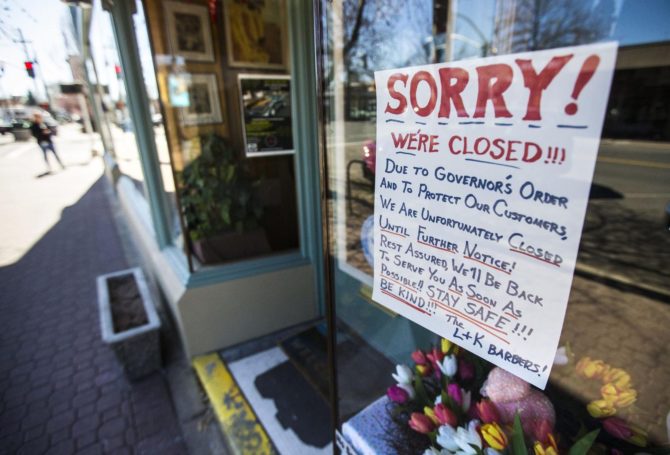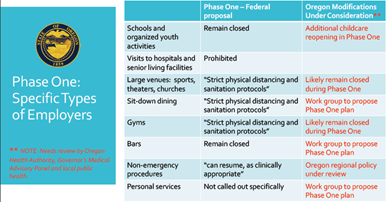
Governor Kate Brown has outlined a three-phase, county-by-county reopening plan, the legislative Emergency Board is preparing to authorize $30 million in COVID-19 relief funding and state leaders are bracing for a quarterly revenue report next month that could show up to a $3 billion drop in tax revenue. Washington Governor Jay Inslee has released a similar phased reopening proposal.
The Oregon reopening plan, which Brown released this week, is still in draft form. A series of industry-specific work groups representing restaurants/food service, retail, personal services, childcare, transit and outdoor recreation will convene this week and develop recommendations to Brown by May 4 that will lead to a final plan. Brown emphasized the final plan could differ and include more detail and specific timelines. She also indicated she will rely heavily on advice from the Oregon Health Authority (OHA) and public health experts before lifting all or parts of her stay-at-home order.
The Oregon reopening plan generally follows President Trump’s ‘Opening Up America Guidelines’ with some notable changes. One variation would require counties to seek permission to reopen and provide assurances they have an adequate supply of personal protective equipment, support from their local public health officer and a commitment from area hospital leadership. Harney County legislators have already floated a proposal for a slow rollout of business by May 1.
Phase 1 of the draft Oregon reopening plan would allow a staggered industry reopening based on recommendations from respective work groups. We could expect:
- Flexibility for restaurants and the hospitality industry to expand services, including sit-down dining;
- Approval for non-emergency medical procedures in hospitals and clinics;
- Relaxed restrictions on childcare facilities; and
- Some latitude for personal services such as nail salons, barbershops and tattoo parlors.
Large venues and gyms will likely remain under closure orders during Phase 1. Social distancing and safe hygiene requirements, especially in reopened workplaces, would be required.
Geographical considerations under the plan would include declining growth in symptoms and cases, regional testing capacity, regional hospital capacity, regional contact tracing capacity and regional coordination with OHA.

Phase 2 and 3 would only occur after 14 days of improving or stable numbers of confirmed COVID-19 cases and hospitalizations in the state. Phase 2 might permit, with social distancing, gatherings of up to 50 people in schools and gyms. Non-essential travel would be allowed. In Phase 3, mass gatherings, unrestricted staffing in workplaces and nursing home visitations could resume.
Oregon lawmakers will continue to defer meeting in a special session to await the quarterly economic report, which is expected to be coated in red ink and test legislative resolve over whether to dip into reserves and the state’s $2 billion Rainy Day Fund to backfill anticipated budget holes.
The Emergency Board will vote on a package that includes:
- $50 million – Oregon Business Development Department (OBDD) Federal Funds expenditure authority to establish an emergency loan program for stabilizing Critical Access Hospitals across Oregon.
- $300 million – Department of Administrative Services (DAS) authorization to spend Federal Fund Coronavirus Relief Fund (CRF) dollars from the CARES Act on approved expenses.
- $20 million – Department of Human Services (DHS) authority to spend a special purpose appropriation for non-state employee bargaining costs.
- $12 million – Housing and Community Services Department for rental assistance and safe shelter alternatives (General Fund).
- $10 million – OBDD for financial assistance to small businesses affected by COVID-19 that are unable to apply for federal emergency assistance (General Fund and Lottery Fund).
- $10 million – DAS for a grant to the Oregon Community Foundation to oversee a culturally specific, community-based grant program to make payments to workers who are ineligible for wage replacement payments from traditional unemployment insurance programs (General Fund).
- $3.5 million – Department of Human Services for long term care proactive testing and training for facility staff (General Fund).
- $2 million – Department of Justice for emergency housing for victims of domestic and sexual violence (General Fund).
Congress is expected to pass today and Trump will sign legislation to add another $310 billion to the depleted Paycheck Protection Program, as well as direct $75 billion to hospitals and $25 billion for coronavirus testing. Local government advocates had sought additional financial assistance to cover their COVID-19 costs and replace lost state and local tax revenues. Oregon officials announced plans to start processing next week unemployment insurance claims for self-employed and gig workers, who became eligible because of provisions in the federal CARES Act.
At a business-sponsored event this week, Brown said the state would waive penalties for first-quarter payments under the new Commercial Activity Tax, which took effect January 1. Brown said she opposed pausing the tax, as business groups have urged. The governor indicated the Department of Revenue would issue more specific guidance on CAT penalties.



